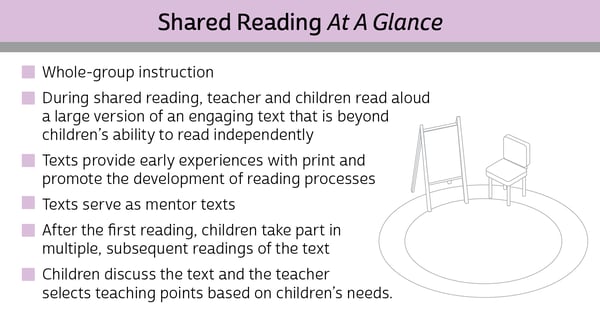*Effective reading instruction involves a combination of powerful instructional settings. This post is the next in our "What is...?" series, where we define each instructional context that makes up a coherent literacy system.
What is shared reading?
During shared reading, you and your students read aloud an enlarged version of an engaging text that provides opportunities for your students to expand their reading competencies. The goals of the first reading are to ensure that students enjoy the text and think about the meaning. After the first reading, students take part in multiple, subsequent readings to notice more about the text. They discuss the text, and you select teaching points based on their needs.
 Why is shared reading important?
Why is shared reading important?
As an instructional context, shared reading:
- Provides enjoyable, successful experiences with print for all students
- Promotes the development of all aspects of the reading process
- Builds language skills and enhances vocabulary
- Provides opportunities to engage in expressive, meaningful, fluent reading
- Builds understanding of various types of texts, formats, and language structures
- Builds a community of readers
"Shared reading enables all children, regardless of their reading levels, to have enjoyable literacy opportunities every day." – Irene C. Fountas and Gay Su Pinnell
What does shared reading look like?
Students sit together as a whole group and, following your first reading, engage in an oral reading of a common text. They use their voices to interpret the meaning of a text as they read in unison with others. Alternatively, students are assigned parts to read.
Structure of a shared reading lesson:
- Introduce the Text – Engage students' interest in the text with a few opening words.
- Model Reading of the Text – Read the text to students at a good pace with a focus on enjoyment and understanding. Have a brief discussion.
- Read the Text Together – Have students read the whole text or selected parts with you.
- Discuss the Text – Guide conversation about the meaning and language of the text, and invite students to share their thinking.
- Teaching Points – Select a specific part or parts of the text to revisit to make teaching points. This can be accomplished over a number of subsequent readings.
- Repeated Readings – Revisit the text again on subsequent days, making additional teaching points and supporting students in gaining independence in processing the text.
Shared reading is an enjoyable experience for your classroom community and an important opportunity for children to “step up together” into more challenging texts while also beginning to notice and acquire the processes they need to read texts independently.
To learn more about the Fountas & Pinnell Classroom™ Shared Reading Collection, click the link below.
~The Fountas & Pinnell Literacy™ Team
Check out the entire "What is?" blog series:






